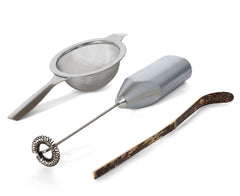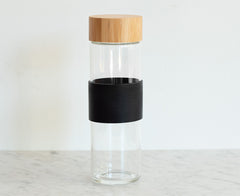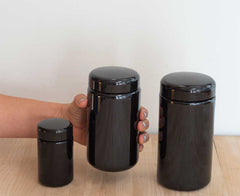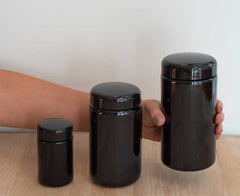Caffeine is a fabulous chemical compound, and many of us have a strong relationship with it. In the US, 62% of adults drink coffee every day, at an average of three cups per day. We’re officially hooked! As a coffee aficionado myself, I really get it why so many people love and depend on coffee. But is that relationship perhaps a bit codependent?
For folks exploring whether a switch to a morning cup of matcha tea might be better for their health and wallets, we’re excited to put together this guide on the ways matcha is superior to coffee, and how you can get started with a new daily habit.
Matcha vs. Coffee: Top 5 Benefits of Matcha
Here are the top five reasons why matcha is the winner in the caffeine-off of matcha vs. coffee.
1) Matcha has a better caffeine high
Coffee’s caffeine high wreaks havoc on the body. It starts off with a blast, and ends in a crash. Here’s the science explaining why: Coffee causes spikes in adrenaline glucose and insulin levels, which in turn create jitteriness and nervousness.
Matcha, in contrast, does none of that. It creates a calm alertness with just a sixth the caffeine of coffee (25mg versus a typical 150mg cup of coffee). There are no spikes and crashes, it just comes on gently and leaves just as gently.
How is this possible? Well, the 25mg of caffeine in a cup of matcha binds with matcha’s phytonutrients (especially L-theanine) in a way that slows the body’s absorption of the caffeine. So your lower caffeine “buzz” typically lasts at least three hours, though some people report feeling it for as long as six or seven.
Matcha, it turns out, is a sort of anti-cortisol. It helps stabilize your blood sugar levels and reduces stress on the adrenal glands. Specifically, the L-theanine in matcha is thought to reduce levels of cortisol by creating alpha waves in the brain to produce a state of calm and serene alertness.
Coffee does the opposite: it causes an adrenaline and cortisol spike.
Go on a deeper dive on the science of matcha and caffeine here:
- Matcha Has Less Caffeine, But the Caffeine Lasts Longer
- Matcha — The Anti Cortisol
- Caffeine: Can I Drink Matcha During Pregnancy?
- Matcha and Caffeine, Revisited
2) Better breath
Matcha is much better for your teeth than coffee or black tea. Green tea thwarts the bacteria that causes plaque, making it a powerful ally for everyday oral hygiene. Actually, l ots of dentists in Japan recommend a daily matcha!
Here’s why: The exceedingly high catechin (notably EGCG) content of matcha acts as a kind of sterilizing agent. These catechins have antibacterial effects, and in essence, they act as microscopic plaque “scrubbers” that can help prevent cavity formation and periodontal disease.
A cup of matcha after a meal slows the growth of germs that cause periodontal disease and halitosis (bad breath). Learn more here: Why Dentists Love Matcha.
3) Better skin
Green tea has been showing up plenty as an ingredient in skincare products, but the best way to get the skin benefits of matcha is to drink it. While coffee’s higher quantities of caffeine may cause physical stress resulting in acne, matcha’s low caffeine content and beneficial components may actually do wonders for your skin.
According to this analysis of 20 studies, drinking green tea may be effective in the scavenging of free radicals, cancer prevention, hair loss, and skin aging.
Another green tea-centered study of women aged 40 to 65 found that green tea drinkers had skin with 25% less redness in reaction to a dose of UV radiation — it is thought that the green tea provided a barrier to the damage from the sun. (Though if you start drinking matcha, please do keep wearing sunscreen too!) This same group of tea drinkers also had more elastic skin at the end of the study, as well as less roughness and dryness compared to the non-tea drinkers.
Keep reading: How Matcha Can Help Your Skin
4) More antioxidants
Matcha is ridiculously full of antioxidants, catechins, flavonoids, and polyphenols.
Catechins are phenolic compounds found in tea, cocoa, and berries. They're considered potent in antioxidant activity, and can regulate blood pressure, promote weight loss, and help prevent disease.
Flavonoids are phenolic compounds that can be found in most plant-based food and in particular, tea. Their benefits include anti-inflammatory effects and helping protect cells in the body from oxidizing, preventing cardiovascular diseases and other diseases like diabetes, cancer, and dementia.
Polyphenols are naturally occurring organic compounds also found in plant-based foods like matcha, and serve as natural antioxidants. They promote cardiovascular health and can help manage blood sugar and blood pressure, promote circulation, and reduce chronic inflammation in blood vessels.
Matcha also contains the mighty epigallocatechin gallate (EGCG), which has been linked to many health benefits and has therapeutic applications to the treatment of so many disorders, including cancer (according to one study).
Check out our research database for more than a thousand published scientific and medical papers on green tea's effects on human health.
5) It's WAY easier to make great matcha than great coffee
Matcha may have a reputation of being difficult to make, but seriously, does this sound hard?
- Scoop sifted tea into a cup
- Add hot water (170F max; never boiling!)
- Whisk — and that’s it!
It just takes 30 seconds to reach perfection — assuming you’re starting with great matcha, of course.
In comparison, to make a great cup of coffee, it should be measured (20 grams seems to be the most common weight), freshly ground, then steeped or steamed, using a variety of complicated and expensive machinery. And then there’s the waiting for the machine to do its thing.
Matcha is easier to perfect, requiring fewer technical tools and fewer steps. So what are you waiting for? It’s time to make the switch.
New to Matcha?
Our Start Here Kit is the perfect way to make your first cup.
Transitioning from coffee to matcha: getting started
What will it feel like to make the switch? It’ll be different for everyone, but one convert told us, “The effect of the caffeine feels different. Sometimes I miss the jolt, but I definitely don't miss the jitters.” Remember to be kind to yourself throughout the process. This is hard — but worth it!
Give yourself time to transition
Switching from coffee to matcha takes time. Remember, with 150mg of caffeine in a cup of Starbucks coffee and 25mg in a typical cup of matcha, your body will need time to adjust to the change in caffeine amounts.
Here are our best tips for making the switch:
- Take at least two weeks to gradually switch. If you drink more than one cup of coffee a day, begin by reducing that amount and substituting matcha for your second cup or afternoon pick-me-up before completely replacing coffee with matcha
- Drink plenty of water. This may help with caffeine withdrawal headaches as well as assist in the shift in body chemistry you’re undergoing.
- Read more advice on switching without going “cold turkey” here
Use the right matcha tea and supplies
To have a great experience with matcha, the details matter: the way you brew, prepare, and serve matcha has a big impact on the overall taste and experience.
There is pleasure in ritual, for sure. Most people have a favorite mug or cup, the one that fits just so in your hand. Though you don’t need anything other than high-quality, ethically sourced powder, hot (never boiling!) water, and a mug to make a great cup of matcha, we do recommend using these tools for greater authenticity, taste, and an enhanced experience:
- Use a good ceramic tumbler or cup for best taste results. Here are some of our favorites.
- Use a traditional matcha scoop to measure the correct amount (½ teaspoon, or about 1 gram) into your cup every time. (Though we see a lot of matcha newbies who don't use enough powder; if you're going to err, err on the bigger side -- this will help make a tastier cup with better crema.
- Sieve your matcha powder through a matcha sieve (before adding water) to prevent clumping. This is best when done by pushing the matcha through the sieve, and into the cup, with your scoop.
- Finally, blend your matcha to creamy perfection with an electric milk frother. This will ensure that the powder is fully dissolved and distributed in your water for the best taste. Plus, the beautiful crema that forms on top will make transitioning away from frappuccinos even easier!
Get started right away with your new matcha routine using our Matcha Tea Tool Kit, which contains a matcha scoop, sieve, and frother. It’s everything you need to make your morning cup a soothing, delicious ritual.
Make matcha your favorite way
Whether you’re an iced coffee snob or splurge on fancy store-bought lattes, matcha can replace coffee in your life on your terms.
Coldbrew Matcha
Unlike coldbrew coffee, coldbrew matcha doesn’t require any lengthy or complicated extraction technique. Just add matcha to cold water and ice in a shakeable container like a mason jar or water bottle, then shake it like hell!
This is a great matcha delivery method for people who love all things iced,. Plus, it’s even faster than heating up water, so you can be out the door quickly.
Check out our Coldbrew Tutorial to learn more, or read The Many Joys of Coldbrew Matcha.
Matcha Latte
We don’t recommend pouring a bunch of milk or sugar into your matcha, as it dilutes the flavor and overall effect, but if you’ve got a sweet tooth, we won’t stop you.
Whether you blend up an icy frozen matcha latte or prefer yours hot with steamed or frothed milk, you can easily replace your expensive Starbucks coffee habit with a superior experience at home.
We recommend using culinary-grade matcha when making matcha with milk. This one is perfect for lattes.
Matcha, Breakaway Style
Matcha is traditionally prepared in a wide, shallow bowl, and hand-whisked with a bamboo whisk. This is a beautiful process, but it takes some practice to master. So we’ve adapted this process for non-expert matcha drinkers to enjoy the same level of quality with some more modern tools.
Watch how to make the perfect cup of matcha in one minute, Breakaway style.
Why not switch to matcha? There is no downside!
Needless to say, matcha is not intended to prevent, treat, or cure any disease. It’s just green tea, albeit a very special one that has all kinds of interesting health properties.
Because there are no known downsides or side effects to regular consumption of matcha, there is little to lose in making the switch from coffee to matcha, at least some of the time.
You may not need to give up coffee altogether. But do give matcha a try. You have nothing to lose but stained teeth, bad breath, and heart-pounding jitters. And you might have a whole new world of wellness and joy to gain.
Get started with Breakaway Matcha’s Start Here Kit to discover your new morning ritual.




